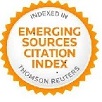Battle Speeches, Rhetoric and Historiography: Reflections about Syrianus Magister's Rhetorica militaris
Keywords:
Syrianus, Battle exhortation, Rhetoric, Historiography, Graeco-Roman Antiquity, ByzantiumAbstract
The first part of this essay reviews the recent book published by Immacolata Eramo on the War Speeches (Bari 2010) by the Byzantine rhetor Syrianus Magister. This book offers a careful edition, the first full translation ever made of the text and a detailed commentary. In the second part, we also analyse the relation between battle speeches and rhetorical norms from Antiquity to Byzantium in order to show the importance and signification of this Byzantine handbook, whose authentic value can only be appreciated if we consider the Greco-Latin historiographical and rhetorical tradition in which the military harangue is inserted.
Downloads
References
AHRWEILER,H.(1967),“Un discours inédit de Constantin VII Porphyrogénète”, Travaux et Mémoires 2, 393-404.
ALBERTUS,J.(1908),Die paraklêtikoí in der griechischen und römischen Literatur, Estrasburgo.
CARMONA CENTENO, D. (2008), La epipólesis en la historiografía griega y romana, tesís doctoral, Cáceres: Universidad de Extremadura.
DAIN, A. (1953), “Le encyclopédisme de Constantin Porphyrogénète“, Bulletin de l'Association Guillaume Budé 4, 64-81.
____ (1954), “La transmision des textes littéraires classiques de Photius à Constantin Porphyrogénète”, Dumbarton Oaks Papers 8, 31-47.
ERAMO, I. (2007), “῏Ω ἄνδρες στρατιῶται. Demegorie protrettiche nell’AmbrosianusB 119 sup.”, Annali della Facoltà di Lettere e Filosofia dell’Università degli Studi di Bari50, 127-165.
____ (2010), “Retorica militare fra tradizione protrettica e pensiero strategico”, Talia dixit 5, 25-44.
HANSEN,M.H. (1993), “The Battle Exhortation in Ancient Historiography. Fact or Fiction?”, Historia 42, 161-180.
HORNBLOWER, S. (2008), A Commentary on Thucydides. Vol. III, Oxford: University Press.
IGLESIAS-ZOIDO,J.C.(2003), “La arenga militar en Jenofonte: a propósito de Ciropedia 3.3.48-55”, Norba 16, 157-166.
____ (2007), “The Battle Exhortation in Ancient Rhetoric”, Rhetorica 25, 145-165.
____ (2007a) “Historiografía e instrucción retórica: el ejemplo de la arenga militar”, en J. A. Fernández, F. Pordomingo y A. Stramaglia (eds.), School and Literature in Ancient Greece, Montecassino: Università di Montecassino, pp. 107-120.
____ (2010), “Una figura olvidada: el rétor Lesbonacte”, en Actas del XII Congreso Español de Estudios Clásicos. Valencia, Octubre de 2008, vol. II, Madrid: SEEC, pp. 381-388.
____ (2010a), “Aproximación a las claves de la más reciente investigación sobre la arenga militar (2008-2010)”, Talia dixit 5, 91-110.
____ (2011), El legado de Tucídides en la cultura occidental: discursos e historia, Coimbra: CECH.
IGLESIAS-ZOIDO, J.C. (ed.) (2008), Retórica e historiografía: el discurso militar en la
historiografía desde la Antigüedad hasta el Renacimiento, Madrid: Ediciones Clásicas.
KEITEL, E. (1987), “Homeric Antecedents to the Cohortatio in the Ancient Historians”, Classical World 80, 153-172.
MCGEER, E. (2003), “Two military Orations of Constantine VII”, en N. Oikonomides (ed.), Byzantine Authors: Texts and Translations dedicated to the Memory of N. Oikonomides, Leiden: Brill, pp. 111-135.
MOSSE, C. (1963), “Armée et cité grecque (à propos de Thucydide VII.77.4-5)”, Revue des Études Anciennes 65, 290-297.
NICOLAI, R. (1992), La storiografia nell'educazione antica, Pisa: Giardini.
____ (2001), “Il generale, lo storico e i barbari: a proposito del discorso di Brasida in Thuc. IV 126”, in G. Arrighetti (ed.), Letteratura e riflessione sulla letteratura nella cultura classica. Atti del Convegno Pisa, 7-9 giugno 1999, Pisa, pp. 145-155.
PRITCHETT,W.K.(1994),“The General’s Exhortations in Greek Warfare”, en Essays in Greek History, Amsterdam: Giessen, pp. 27-109.
____ (2002),Ancient Greek Battle Speeches and a Palfrey, Amsterdam: Giessen.
RANCE, Ph. (2007), “The Date of the Military Compendium of Syrianus Magister (Formerly the Sixth-Century Anonymus Byzantinus)”, Byzantinische Zeitschrift 100, 701-737.
ROMILLY, J. de (1956), Histoire et raison chez Thucydide, París: Belles Lettres.
SCHMID, W. T. (1992), On manly courage: a study of Plato's Laches, Southern Illinois: University Press.
TARAGNA, A.M. (2000), Logoi historias. Discorsi e lettere nella prima storiografia retorica bizantina, Alessandria: Edizioni dell’Orso.
____ (2004), “Logos e polemos: eloquenza e persuasione nei trattati bizantini di arte militare”, Siculorum Gymnasium 57, 797-810.
TATUM, J. (1989), Xenophon’s Imperial Fiction (On the Education of Cyrus), Princeton: University Press.
VARI, R. (1908), “Zum historischen Excerptenwerke des Konstantinos Porphyrogenetos”, Byzantinische Zeitschrift 17, 75-85.
ZUCKERMAN, C. (1990), “The Military Compendium of Syrianus Magister”, Jahrbuch der Österreichischen Byzantinistik 40, 209-224.












